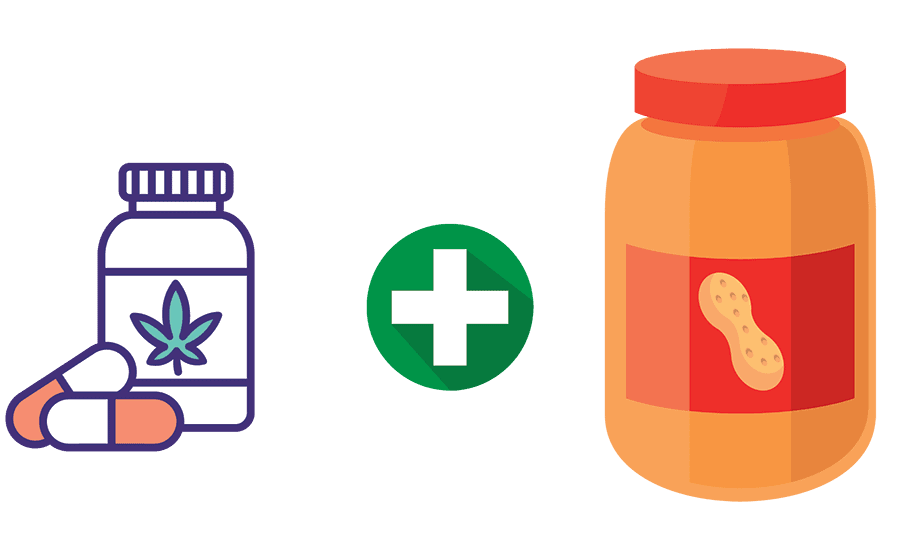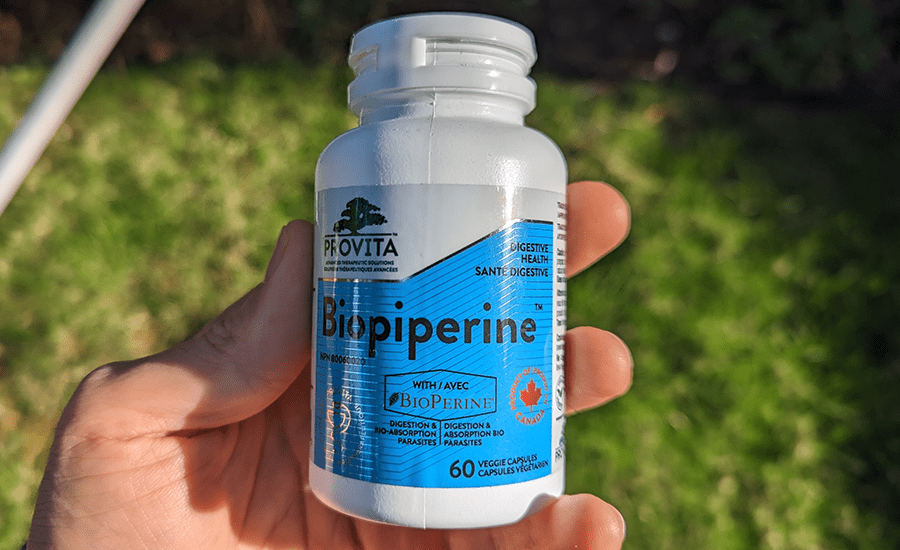Key takeaways:
- Increasing CBD’s absorption means greater effects. Absorption is measured by the percentage of CBD that reaches the bloodstream when you take it.
- If you’re taking CBD capsules, gummies, or other oral products, be sure to eat a high-fat meal first. This will boost CBD’s absorption by up to four times.
- If you’re taking CBD oil under the tongue, hold it for at least a few minutes, but ideally as long as possible to boost absorption.
- Vaping CBD offers the highest absorption rate, followed by sublingual CBD oil.
Millions of people are taking CBD oil and other CBD products to help with everything from anxiety to workout recovery. But if you don’t use them properly you can end up spending hundreds of dollars without any noticeable results.
It’s largely because CBD is a fat-soluble compound that’s difficult for our bodies to absorb. That’s why it’s important to understand the concept of bioavailability and how it relates to CBD.
In this article, we’ll cover how cannabidiol is absorbed through different methods and suggest evidence-based tips for making CBD work better.
Table of Contents
What is CBD Bioavailability?
Written as a percentage, bioavailability is the portion of a drug that you took that is actually absorbed into your blood (1).
For example, when you take a 50 mg CBD capsule, your body doesn’t absorb and use all of that 50 mg. Research suggests that CBD’s oral bioavailability can be as low as 6%, which means you’d only be getting 3 mg of that initial 50 mg dose (2).
Meanwhile, if the same 50 mg was injected into your veins, it would have a bioavailability of 100% because all of the CBD goes directly into your bloodstream.
Higher bioavailability means you have to take less CBD to get the effects you’re after and can mean the difference between seeing benefits and seemingly no change. That’s why it’s important to understand how the bioavailability of CBD varies depending on the way you take it.
CBD Administration Routes
The vast majority of people use CBD in one of four administration routes:
- Oral: swallowing CBD
- Sublingual: putting CBD under your tongue
- Inhalation: smoking or vaping CBD
- Topical: applying CBD to your skin
Here’s a look at the differences in bioavailability between these four:
Oral CBD
Made popular by vitamins and other supplements, the oral method involves ingesting CBD capsules, tablets, gummies, and other edible products (or even pure CBD powder). While this route is easy and convenient, it also has the lowest bioavailability out of any administration method.
When you ingest CBD, you will only absorb ~6-24% of it (a range that depends largely on whether the CBD was taken alongside fats; more on that later) (2).
That’s because of first-pass metabolism — the reduction in drug concentration that happens in the digestive system, before the CBD can reach your bloodstream (3). In particular, much oral CBD is lost in the liver before it reaches systemic circulation.
Sublingual CBD
The sublingual method means putting CBD under your tongue. This is the route used by CBD oil, but you can also use CBD sprays, sublingual strips, lozenges, and even pure CBD powder.
Since the mucous membranes under your tongue are rich in capillaries (tiny blood vessels), CBD is absorbed directly into the blood, bypassing the digestive tract. As a result, the sublingual bioavailability of CBD is significantly higher than oral (4).
The sublingual route is arguably the most effective CBD administration method because it combines good bioavailability with relatively fast and long-lasting effects and easy dosage control.
Although there isn’t much research data on the exact bioavailability of sublingual CBD, we know that CBD taken intranasally as a spray has a bioavailability of 34-46% (5). Since this administration route is similar to sublingual (your nose also contains mucous membranes rich in blood vessels), we can use it as a rough estimate for CBD’s sublingual bioavailability.
Inhaled CBD
Inhaling CBD means smoking hemp flower or vaping CBD e-liquid. Similar to the sublingual route, this method has fairly high bioavailability. One study found that the bioavailability of smoked CBD was about 31% (range of 11 to 45%) (6).
Another advantage of inhaling CBD is that the effects are nearly instant, making it an excellent option when you need immediate relief. But it does last less than the sublingual route — about 1-2 and a maximum of 4 hours (7).
Topical CBD
Applying CBD to your skin is a little different because it’s only going to act on the specific area you applied it to.
The only exception to that is transdermal formulations which are designed to absorb through your skin and into the bloodstream, which means they can have comparable effects to other methods (8). However, these formulations are relatively new and there’s no way of knowing if a product that claims to be transdermal actually works.
Tips to Maximize CBD Absorption & Effects
As we can see, one easy way to make CBD more effective is to opt for sublingual or inhaled products over oral formulations like capsules or gummies. But there’s a lot more to it than that. Here are some more evidence-based tips to get the strongest effects out of CBD.
Use Full-Spectrum Products Over Pure CBD
Full-spectrum CBD extracts contain a complete range of beneficial hemp cannabinoids and terpenes.
These compounds work synergistically to produce the “entourage effect,” making full-spectrum CBD products more beneficial than pure CBD isolate. For example, research suggests that terpenes may help cannabinoids cross the blood-brain barrier, enhancing their effects (9).
According to one 2018 paper, full-spectrum, CBD-rich cannabis extracts were about 4 times more potent than pure CBD (10).

Take CBD with Fats
If you’re taking CBD by mouth it’s recommended to have a high-fat meal first. CBD is a fat-soluble compound, so fats help your body absorb it (which is why CBD oil is the most popular way to use CBD).
In fact, studies suggest that taking CBD within 30 minutes of a high-fat meal (like a breakfast burrito containing 500-600 calories of fat) versus an empty stomach increases its bioavailability by four times — from only 6% to 24% (11).
This tip is less important if you’re taking CBD orally in a form that already contains fats, such as softgels or brownies. But since the amount of fat in these products isn’t that high, you’re still likely to see increased absorption if you take them after eating high-fat foods.
I definitely notice significantly stronger effects from CBD softgels and gummies when I eat something high in fat beforehand, like peanut butter or yogurt. Something as simple as eating a few spoons of peanut butter before taking CBD is enough.
You can even use this tip for CBD oil because you’re still going to absorb some of the CBD orally after you hold it under your tongue and swallow it. But the benefit is going to be smaller compared to capsules or gummies.
Follow Proper Technique
Another easy way to increase CBD bioavailability is to follow the proper technique for your chosen administration method.
Sublingual
The best way to make CBD oil work better (or any other CBD product that you take sublingually) is to hold it under your tongue for as long as possible. Although most products recommend holding it for 30-60 seconds, longer is better because more of the CBD will have time to absorb.
I recommend holding CBD under your tongue for at least 3 minutes or even longer. I try to hold CBD oil for 10-15 minutes and notice significantly faster and arguably stronger effects compared to only one or a few minutes.
If holding CBD oil under your tongue gets uncomfortable, you can also hold it next to your cheeks and gums or swish it around: there are blood vessels here that can absorb CBD as well.
Inhalation
Although targeted studies are lacking, research suggests that your breath depth, how long you hold the smoke or vapor, and even vaporizer temperature can affect how well your body absorbs inhaled cannabinoids like CBD and THC (12).
When vaping or smoking CBD products, you can follow one of the two main methods: direct-to-lung (inhaling vapor or smoke directly into your lungs) or mouth-to-lung (inhaling into the mouth first and inhaling again into the lungs). As a general recommendation, holding for at least a few seconds may be ideal, but more research is needed.
As for CBD vaping temperature, again, there isn’t a whole lot of evidence. Your best bet is to use a device specifically designed for vaping CBD.
If you’re using a proper vape mod, you can experiment with a range between 160-230°C (320-446°F); the former is the lowest temperature at which CBD starts to vaporize, while the latter is the optimal temperature for vaping CBD reported by a 2014 study (13).
Topical
If you’re applying CBD topically in the form of creams, lotions, oils, and other products, the standard rules apply: make sure your skin is dry and massage the product in to ensure optimal absorption.
Try Piperine Or Other Absorption Enhancers
Another less-common tip for oral CBD is to use bioavailability enhancers: compounds that help your body absorb supplement ingredients (14).
The best-known example is piperine, a natural compound found in black pepper. It’s frequently added to curcumin and other dietary supplements to enhance their absorption.
A 2020 study in rats found that piperine increased the oral absorption of CBD by 2.5 times (15). If you want to give this a try, your best option is to buy a separate piperine supplement, which are relatively cheap.

A Word on Nano CBD
One last thing to mention is nanotechnology, which holds the greatest promise of increasing the oral bioavailability of CBD and indeed all drugs. Research into nanoformulations for CBD is ongoing and showing promising results.
For example, a 2019 study of a CBD nanoemulsion reported greater oral absorption than regular CBD oil in rats (16). Similarly, a 2018 study in healthy men reported faster absorption and 31% greater CBD bioavailability from a THC/CBD nanoformulation compared to Sativex (a 1:1 THC/CBD drug) (17).
But the problem with CBD nanoformulations is that they’re not yet widely available in commercial products. Even though you can find many companies advertising “water soluble” and “nano CBD” there isn’t much evidence to prove that these products have enhanced bioavailability.
Summing Up: Increasing CBD Bioavailability
I hope these tips and explanations help you get the most out of CBD. Of course, don’t forget that dosage also plays a role. If you take a small dose of CBD it might not matter that you’re doing everything right to increase its bioavailability.
Sometimes, you simply need to up your CBD dosage. The best approach is to “start low and go slow” (18). Begin with the amount suggested by your product, give it at least two hours to see the effects, and gradually raise the dosage over time if needed.
Repeat this until you find just the right amount that gives you the desired effects. As a general guideline, most people take 20-100 mg doses of CBD once or twice a day.
References
- Price, Gary, and Deven A. Patel. “Drug bioavailability.” StatPearls [Internet]. StatPearls Publishing, 2021.
- Perucca, Emilio, and Meir Bialer. “Critical aspects affecting cannabidiol oral bioavailability and metabolic elimination, and related clinical implications.” CNS drugs 34.8 (2020): 795-800.
- Herman, Timothy F., and Cynthia Santos. “First pass effect.” (2019).
- Hosseini, Adele, Andrew J. McLachlan, and Jason D. Lickliter. “A phase I trial of the safety, tolerability and pharmacokinetics of cannabidiol administered as single‐dose oil solution and single and multiple doses of a sublingual wafer in healthy volunteers.” British Journal of Clinical Pharmacology 87.4 (2021): 2070-2077.
- Paudel, Kalpana S., et al. “Cannabidiol bioavailability after nasal and transdermal application: effect of permeation enhancers.” Drug development and industrial pharmacy 36.9 (2010): 1088-1097.
- Millar, Sophie Anne, et al. “Towards better delivery of cannabidiol (CBD).” Pharmaceuticals 13.9 (2020): 219.
- Borodovsky, Jacob T., et al. “Smoking, vaping, eating: Is legalization impacting the way people use cannabis?.” International Journal of Drug Policy 36 (2016): 141-147.
- Huestis, Marilyn A. “Human cannabinoid pharmacokinetics.” Chemistry & biodiversity 4.8 (2007): 1770.
- Andre, Christelle M., Jean-Francois Hausman, and Gea Guerriero. “Cannabis sativa: the plant of the thousand and one molecules.” Frontiers in plant science 7 (2016): 19.
- Pamplona, Fabricio A., Lorenzo Rolim Da Silva, and Ana Carolina Coan. “Potential clinical benefits of CBD-rich cannabis extracts over purified CBD in treatment-resistant epilepsy: observational data meta-analysis.” Frontiers in neurology (2018): 759.
- Perucca, Emilio, and Meir Bialer. “Critical aspects affecting cannabidiol oral bioavailability and metabolic elimination, and related clinical implications.” CNS drugs 34 (2020): 795-800.
- Bruni, Natascia, et al. “Cannabinoid delivery systems for pain and inflammation treatment.” Molecules 23.10 (2018): 2478.
- Solowij, Nadia, et al. “A protocol for the delivery of cannabidiol (CBD) and combined CBD and∆ 9-tetrahydrocannabinol (THC) by vaporisation.” BMC Pharmacology and Toxicology 15.1 (2014): 1-8.
- Kesarwani, Kritika, and Rajiv Gupta. “Bioavailability enhancers of herbal origin: An overview.” Asian Pacific journal of tropical biomedicine 3.4 (2013): 253-266.
- Izgelov, Dvora, Abraham J. Domb, and Amnon Hoffman. “The effect of piperine on oral absorption of cannabidiol following acute vs. chronic administration.” European Journal of Pharmaceutical Sciences 148 (2020): 105313.
- Nakano, Yukako, et al. “Development of a novel nanoemulsion formulation to improve intestinal absorption of cannabidiol.” Medical Cannabis and Cannabinoids 2.1 (2019): 35-42.
- Atsmon, Jacob, et al. “PTL401, a new formulation based on pro-nano dispersion technology, improves oral cannabinoids bioavailability in healthy volunteers.” Journal of Pharmaceutical Sciences 107.5 (2018): 1423-1429.
- Lucas, Catherine J., Peter Galettis, and Jennifer Schneider. “The pharmacokinetics and the pharmacodynamics of cannabinoids.” British journal of clinical pharmacology 84.11 (2018): 2477-2482.

Gleb is a freelance writer from Vancouver, Canada specializing in CBD and cannabis. He’s read thousands of studies on CBD and other supplements, helping him translate complex science into plain language. Gleb has tried and reviewed dozens of CBD brands and products, written third-party testing reports, and knows the CBD industry inside and out. When not writing, he likes to kickbox, travel, and tell everyone how awesome intermittent fasting is.





